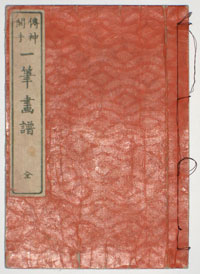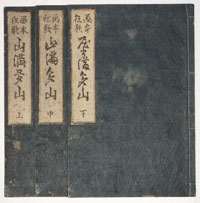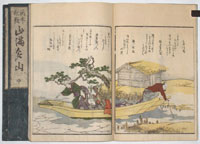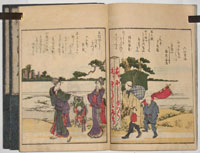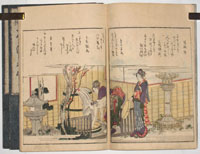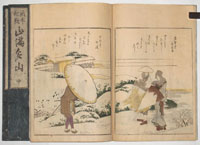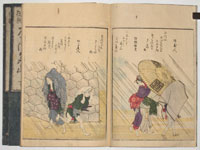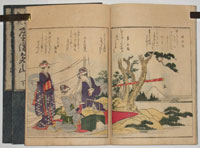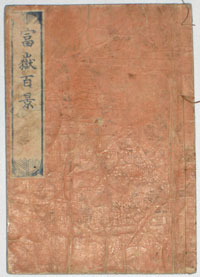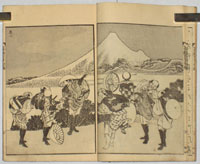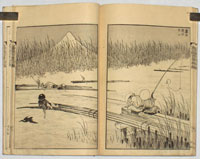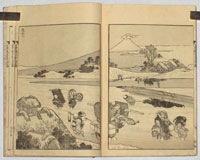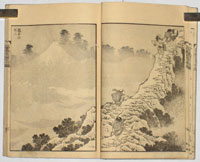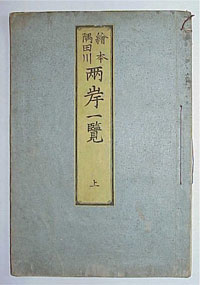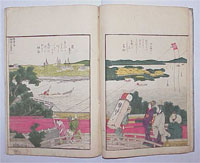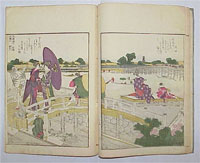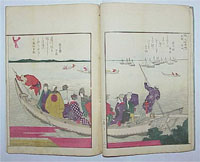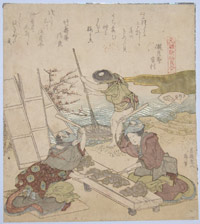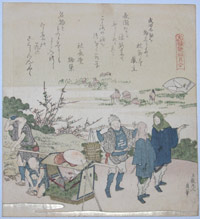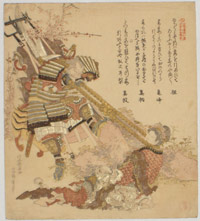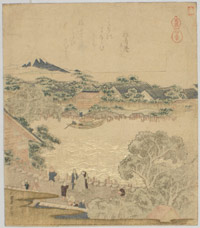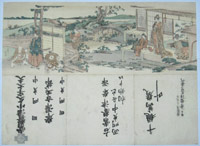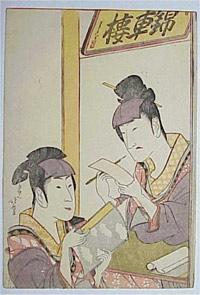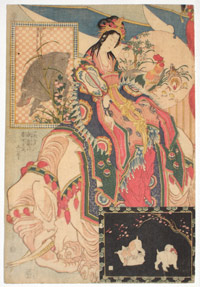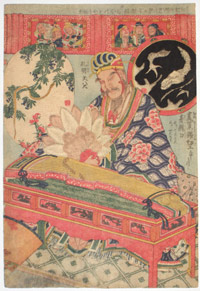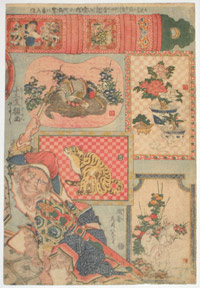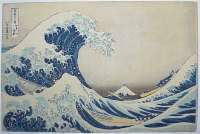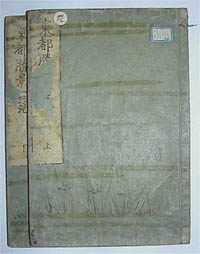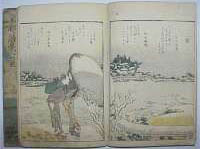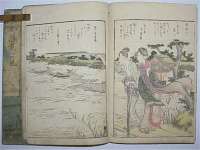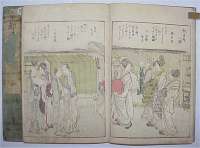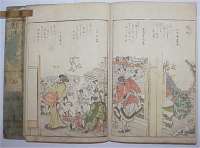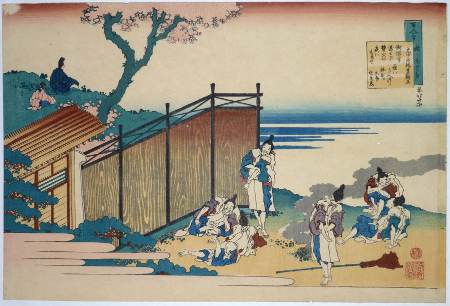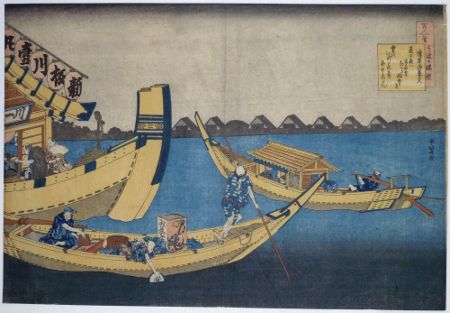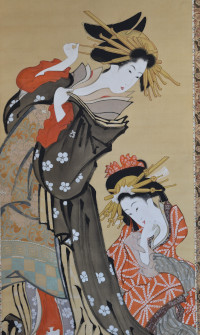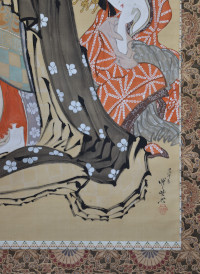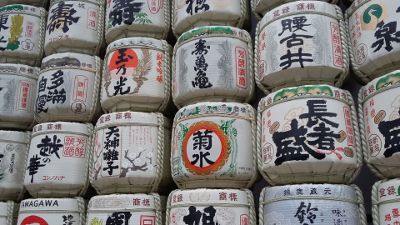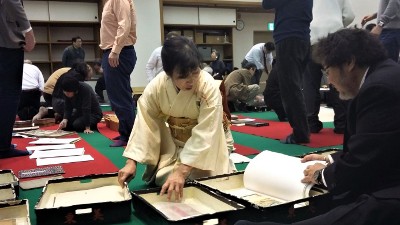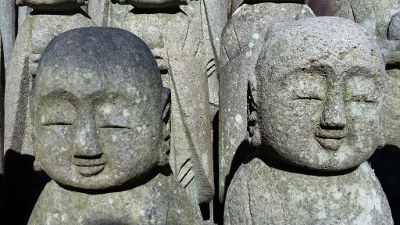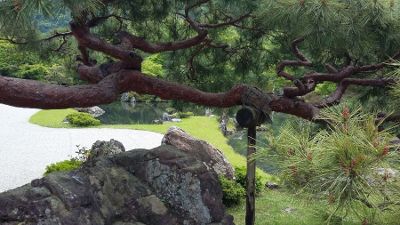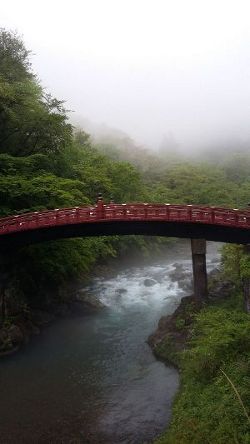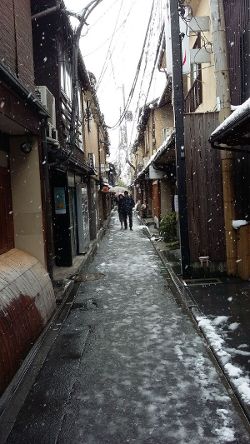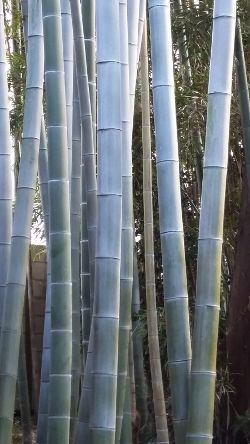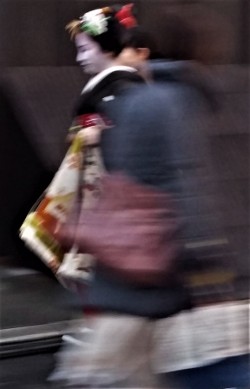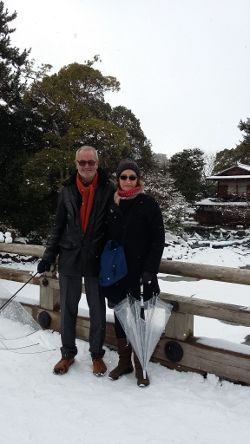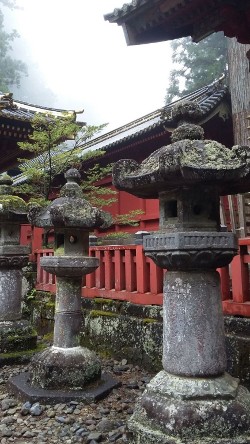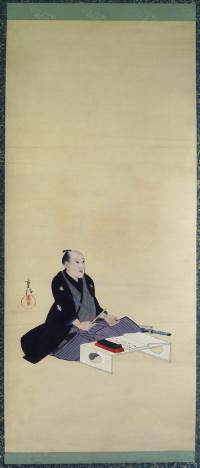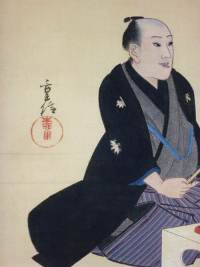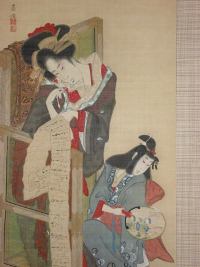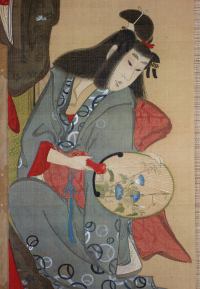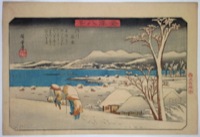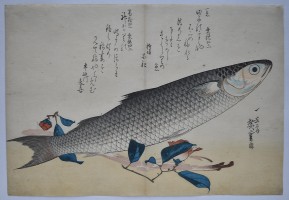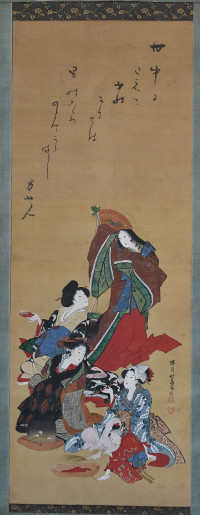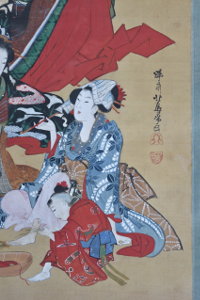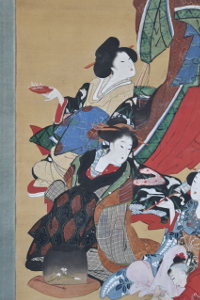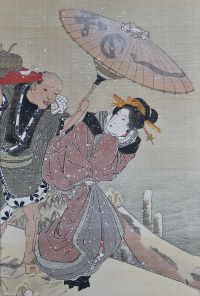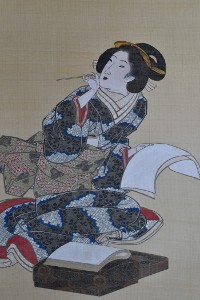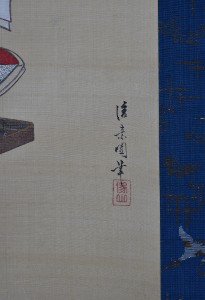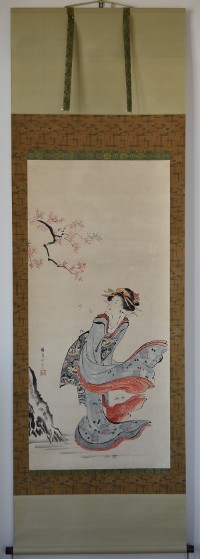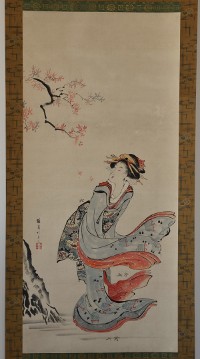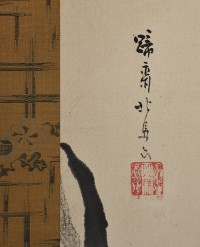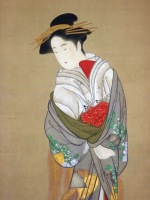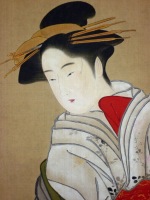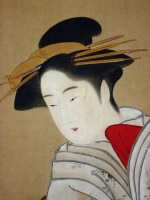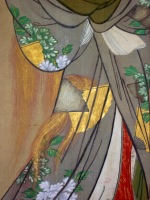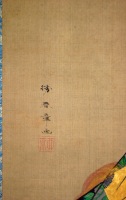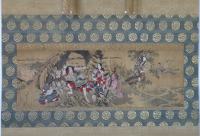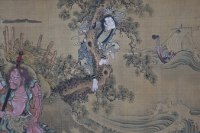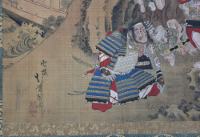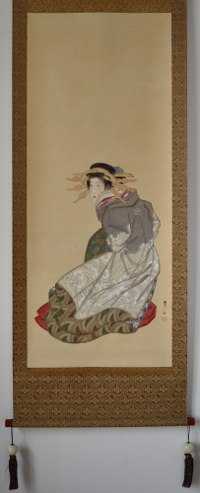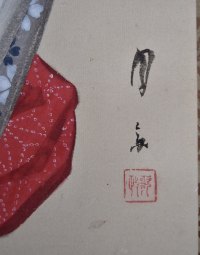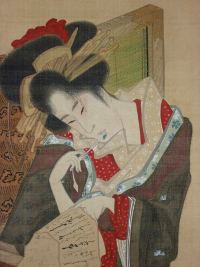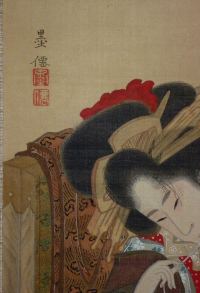Katsushika HOKUSAI (1760-1849)
Click here to view image full size.
One volume complete: Denshin kaishu-ippitsu gafu, “Drawing Manual – Album of Drawing with one Stroke of the Brush.” Similar to the ryakuga style which was pioneered by Masayoshi. One of the best known and most influential of Hokusai’s books and one which was reprinted and copied many times. Published 1823 by Eirakuya Toshiro, Nagoya.
Original burnished orange covers. Original title slip. A nice early example: This is a difficult book to find without the fugitive pigments being completely washed out. This example has been in the collection of four collectors: Jaeger; Kari and the other two unread ( seals inside front cover ).
Status: Sold
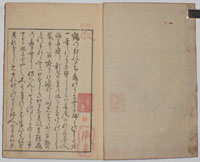
Click here to view image full size.
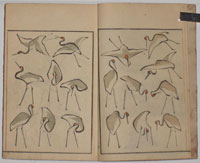
Click here to view image full size.
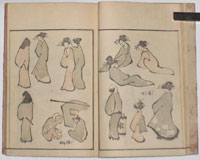
Click here to view image full size.
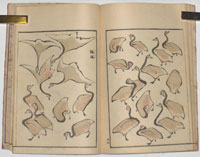
Click here to view image full size.
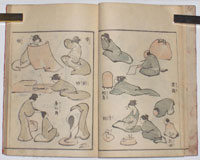
Click here to view image full size.
Katsushika HOKUSAI (1760-1849)
Click here to view image full size.
Three volumes complete: Kyoka yama-mata-yama, “Kyoka: Range Upon Range of Mountains.” The fanciful title is based on the fact that the views illustrated are located around Yama-no-te, the higher ground situated in the north and north-western part of Edo. The pictures accompanied by kyoka poems. This is one of Hokusai’s most admired works. Published 1804 by Tsutaya Jusaburo.
Original dark green embossed covers. Original title slips. A very nice clean copy of this famous book. Some slight smudging of pigments and turning of colour on one or two sheets, but otherwise extremely well retained colour, the elusive blue and purple intact.
Status: Sold
Katsushika HOKUSAI (1760-1849)
Click here to view image full size.
A fine example of the first edition, the “Falcon’s Feather”, of volume one of the Fugaku hyakkei, the “Hundred Views of Mount Fuji.” ( So-called because the title slip is printed in blue with a decorative design of a falcon’s feather – missing on later editions. ) The first volume was published in 3/1834 by the Edo firm of Nishimura Sukezo together with the Nagoya publisher Eirakuya Toshiro and the Edo firms of Kadomaruya Jinsuke and Nishimuraya Yohachi using Hokusai’s favourite engraver, Egawa, amongst others. One of the great and most influential illustrated books. Not just with other Japanese artists, but on European artists of the last century. Full of exquisite compositions, best appreciated in the first or early editions. Due to their popularity, the volumes were reprinted many times. It is also a target for cutting up and separately mounting the pages. Colophon signed: “the old man mad about drawing, formerly Hokusai Iitsu aged 75.”
Original covers and title slip. One small wormhole on a few pages. Otherwise extremely good condition with only minimal soil.
Status: Sold
Katsushika HOKUSAI (1760-1849)
Click here to view image full size.
Volume 1 only of Ehon Sumidagawa ryogan ichiran, “Panoramic Views Along the Bank of the Sumida River”. Published by Senkakudo c1805/6. Minor marks and wormage, otherwise a fine copy, with perfect colour, of the first edition. Original covers and title slip.
Status: Sold
Katsushika HOKUSAI (1760 – 1849)
Click here to view image full size.
Kinutagai, “The Fulling Block Shell” from the series: Genroku Kasen kaiawase, “A Matching Game with the Genroku Poem Shells.” ( An anthology published in 1689. ) A collection of verses with pictures designed by Hokusai printed on 36 sheets. Commissioned by the Yomogawa poetry group for the New Year 1821, Year of the Snake. Shows two women at a fulling block beating down scrap paper to pulp to remake into sheets. In the background a boy is stirring the pulp in a basket in a stream. One of the two best known Hokusai surimono sets. Rare.
Fine impression, very good colour with gold and silver. Minor marks and signs of mounting au verso, otherwise very good condition. Signed Getchirojin I itsu hitsu, “Moonstruck Old Man, Iitsu.”
Status: Sold
Katsushika HOKUSAI (1760 – 1849)
Click here to view image full size.
Sakuragai, “The Cherry Blossom Shell” from the series: Genroku Kasen kaiawase, “A Matching Game with the Genroku Poem Shells.” ( An anthology published in 1689. ) A collection of verses with pictures designed by Hokusai printed on 36 sheets. Commissioned by the Yomogawa poetry group for the New Year 1821, Year of the Snake. Shows travellers on the way to Narita Fudo, the Shinshoji at Naritasan. One of the two best known Hokusai surimono sets. Rare.
Fine impression and colour with gold and silver. Minor marks, otherwise fine condition. Signed Getchirojin I itsu hitsu, “Moonstruck Old Man, Iitsu.”
Status: Sold
Katsushika HOKUSAI (1760 – 1849)
Click here to view image full size.
A rare surimono from a series Soramitsuyaren wakan buyu awase samban no uchi, “Japanese and Chinese Heroes for the Soramitsuya Circle.” ( A club named after its leader Soramitsuya Maeda. ) Shows Benkei in a tug-of-war with a Chinese beauty ( possibly Kosanjo according to Keyes ). Poems by Maeda, Magara and Komichi. Published 1820. Two other impressions illustrated in the Spencer Museum of Art, Surimono, Roger Keyes, Kodansha, 1984, no. 26, p. 74 ( catalogue no 110 ) and the Peter Morse collection catalogue, Ota Memorial Museum of Art, 1988, no. 184.
Fine impression, colour and condition. Extensive gold and silver. Signed Hokusai Taito aratame Katsushika Iitsu hitsu.
Status: Sold
Katsushika HOKUSAI (1760 – 1849)
Click here to view image full size.
A rare surimono from the series Umazukushi, “A Series of Horses” published 1822 ( Year of the Horse ). Shows the banks of the Sumida river, Komatomeishi, with the stone used for tethering horses bottom centre. This surimono is one of three that form a triptych. The complete set is in the Rijksmuseum, Amsterdam ( 1958: 293-294-295 ) and is illustrated in Matthi Forrer, Hokusai, Rizzoli, 1988, no. 265, p. 238 and elsewhere. The other two surimono were also in the Gerhard Schack collection, illustrated in Surimono, 1970, 77-78. Ex collection H. de Winiwater ( seal top right ).
Fine impression with gold and silver. Some soil and loss of the gold. Signed Fusenkyo Iitsu no fude.
Status: Sold
Katsushika HOKUSAI (1760 – 1849)
Click here to view image full size.
A rare long surimono complete with the attached invitation ( yokonagaban ). Mitate junidan soshi, “A Parody from Twelve Fairy Tales.” Shows Ushiwaka and prince Joruri. The invitation is to a dramatic recital with music ( joruri ) organised by Tokiwazu moji kiyo and has the names of the performers: Tokiwazu Komoji dayu; Kishizawa Koshikibu and others from the Kishizawa school. Another example ( lacking invitation ) is illustrated in Masterpieces Of Ukiyoe From The British Museum. Exhibition catalogue of collection of 300 prints from BM exhibited in Japan at Ueno Museum, Tokyo and Nara Prefectural Museum of Art, 1985, no. 194. But otherwise extremely rare as few of these prints can have been produced for this dramatic event. Sometimes the actual designs, without attachments, were reissued at a later date. An early design for Hokusai, c. 1800.
Fine impression with gauffrage. Slight fading and signs, as usual, of the foldmarks on the invitation: These invites were folded three times – once horizontally and twice vertically to form a neat packet. Otherwise very good condition. Signed Gakyojin Hokusai ga.
Status: Sold
Katsushika HOKUSAI (1760 – 1849)
Click here to view image full size.
An exceptionally rare and very unusual koban surimono showing two onnagata actors. The only other recorded impression seems to be in Hokusai, Gian Carlo Calza, Electa, 1999, plate III.57. That has the months on the title slip of book for 1803 (and a poem top left). So this is an egoyomi and my impression must be either a proof or the first issue (same as Harunobu prints issued first without date, then with).
Very fine impression and colour. Signed Gakyojin Hokusai ga.
Status: Sold
Katsushika HOKUSAI (1760-1849)
Click here to view image full size.
Kanagawa Oki Nami-ura from the “Thirty-six Views of Fuji”. The set of forty-six prints published between 1823 and 1829 by Eijudo. Probably the most eulogised Japanese print and the masterpiece from the set as well as being one of the world’s great graphic images.
Medium impression. Blue outline. Very full size. Signed Zen Hokusai I-itsu hitsu.
Status: Sold
Katsushika HOKUSAI (1760-1849)
Click here to view image full size.
Two volumes complete Toto shokei ichiran “A View of the Famous Sights of the Eastern Capital”. Dated Kansei 12 (1800) and published by Tsutaya Jusaburo, Suwaraya Mohei and Suwaraya Ihachi, all of Edo. Original covers, hand-painted with Iris flowers, and title slips. The first edition (probably of 200 copies) was published solely by Tsutaya Jusaburo in 1800 with title Toto meisho ichiran. The example offered here was published shortly afterwards (probably also in 1800). There were also later reprints in 1815 and 1840. One of Hokusai’s best known books and featuring his best work of this period. Difficult to find in an early edition. Ex Kegan Paul Gallery.
Good condition: title slips damaged and some thumbing. A little movement of the blue pigment due to dampness, but overall a nice example of this important work. Signed on colophon Hokusai Tatsumasa.
Status: Sold
Katsushika HOKUSAI (1760-1849)
Click here to view image full size.
A poem by Onakatomi no Yoshinobu Ason from Hyakunin isshu uba ga etoki, the “Hundred Poems explained by the Wet Nurse.” Published by Nishimuraya Eijudo and Iseya Eijudo c 1835/6. Although obviously intended to be a set of 100 prints, only 27 are known plus drawings for the others. The poet speaks of his love being like a fire kept by guards at the Imperial Palace: It only burns hot at night. Shows a group of sleepy imperial guards with the fire burning low. The poet and servant are seen on the distant hill.
Very fine early impression. Fine colour and condition. (The small white area without colour top left should appear on every untrimmed genuine impression.) Signed Zen Hokusai manji (the manji seal black).
Status: Sold
Katsushika HOKUSAI (1760-1849)
Click here to view image full size.
A poem by Kiyowara no Fukayabu from Hyakunin isshu uba ga etoki, the “Hundred Poems explained by the Wet Nurse.” Published by Nishimuraya Eijudo and Iseya Eijudo c 1835/6. Although obviously intended to be a set of 100 prints, only 27 are known plus drawings for the others. The poet speaks of the shortness of the summer night and asks if the moon is still overhead or hidden by clouds. Shows an evening on the Sumida River with a large pleasure boat accompanied by a smaller craft and a vessel providing food.
Fine early impression. Fine colour. Slight centre fold, otherwise good condition. Signed Zen Hokusai manji (the manji seal black).
Status: Sold
Ryuryukyo SHINSAI (1764-1820)

Click here to view image full size.
An original painting, sumi and light colour on silk, 32 x 11 in; 81.3 x 28 csms. Shows three classes in Japanese society: Farmer’s wife, Priest and a Samurai, forced to shelter together at the entrance to a Shinto shrine from a sudden downpour of rain. Above, a rooster and hen also shelter. These birds were allowed to roam freely around Shinto Temples. Shinsai was one of Hokusai’s best pupils. Known for his fine surimono and paintings. Signed Ryuryukyo Shinsai with Ryuryukyo seal. In good condition.
Status: Available
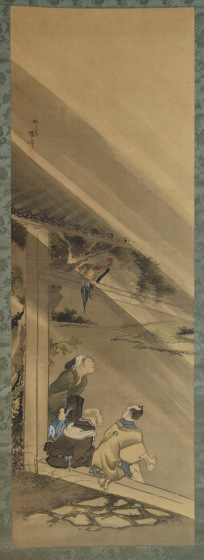
Click here to view image full size.
Katsukawa SHUNSHO (1726-1793)
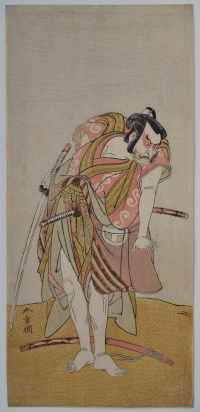
Click here to view image full size.
The actor Otani Hiroji III as a samurai, one sword drawn and facing an adversary. Shunsho was the founder of the Katsukawa school and had many pupils (including Hokusai [Shunro]). He was a prolific designer of hosoban actor prints and produced some of the finest designs in this format. Published c 1775.
Fine impression. Very good colour. Fine condition. Signed Shunsho ga.
Status: Available
Totoya HOKKEI (1780-1850)
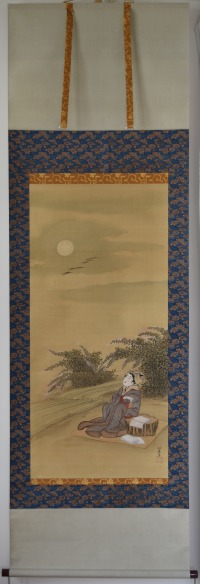
Click here to view image full size.
An original painting by Hokkei, full colour on silk, 41.5 x 19.25 in; 105.5 x 49 cms. Hokkei was one of the earliest and best pupils of Hokusai. Probably best known for his large output of surimono, but also produced illustrated books and paintings. Shows a beauty fulling cloth beside the Kinuta River, Settsu Province. She gazes at the full moon and a flight of geese. On each side of the stream is Japanese bush clover, associated in Japan with autumnal melancholy and unrequited love.
Signed Hokkei ga with Hokkei seal.
Status: Available
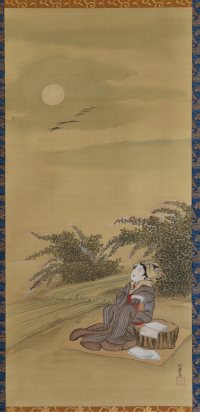
Click here to view image full size.
Teisai HOKUBA (1771-1844)
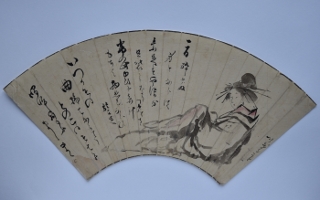
Click here to view image full size.
One of Hokusai’s best pupils. Known for his paintings of beauties but also designed some fine surimono. An original fan painting showing a reclining beauty. Sumi and light red on silvered paper, 7.25 x 17.75 in; 18.5 x 45.2 cms. Removed from a fan, so rib folds and other minor marks. Signed Hokuba ga.
Status: Available
Kawanabe KYOSAI (1831-1889)
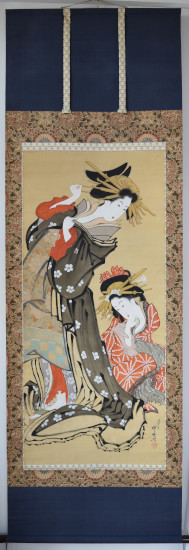
Click here to view image full size.
A large original painting, full colour on silk, image size 48 x 21.75 in; 122 x 55.25 cms. A draughtsman of great dexterity with a wild, often bizzare , imagination. Loved sake, sometimes painting under its influence. At an early stage studied under Kuniyoshi, then Maemura Towa and later Kano Chinshin before becoming an independent painter at 27. Adept at highly finshed paintings but also produced a large corpus of spontaneous paintings. Shows a standing courtesan with her kamuro. An homage to Hokusai whom he obviously admired.
Highly finished in places but also incorporating quirky elements of Hokusai’s style. Signed Hokusai hitsu-i (“Imitating Hokusai’s brush”) Shojo Kyosai. In very good condition with old double box with an untranslatable annotation on inside of lid comparing him to Hokusai. An important new discovery.
Status: Available
Hishikawa SORI (Active 1797-1813)

Click here to view image full size.
An original painting, full colour on silk, 43.25 x 14 in; 109.8 x 35.6 cms. An early pupil of Hokusai (who gave him his name Hishikawa Sori in 1798, it previously being Tawaraya). Generally referred to as Sori III. Produced a considerable number of small surimono – some of which can be confused with Hokusai’s work. Shows a beauty with a monkey at her feet. There is a print closely following the painting published in 1906. Illustrated in Nihon ukiyoe hakubutsukan, ed., Nikuhitsu ukiyoe senshu gekan (Selected Painting of Ukiyo-e, second vol.) Tokyo: Gakushu kenkyusha, 1985, plate 193.
In very good condition. Signed Hyakurin Sori ga with seal Sori.
Status: Available
Totoya HOKKEI (1780-1850)

Click here to view image full size.
An original painting, full colour with gold outline to robe, 32 x 10.75 in; 81.3 x 27.3 cms, on silk. Shows a beauty erotically biting on her hand towel (tenugui) while on the way to a public bath house. This gesture represented deep emotion. Hokkei was one of Hokusai’s earliest and best pupils who not only produced paintings but illustrated books and is especially known for his fine surimono. Illustrated in Nihon ukiyoe hakubutsukan, ed., Nikuhitsu ukiyoe senshu gekan (Selected Painting of Ukiyo-e, second vol.) (Tokyo: Gakushu kenkyusha , 1985). Plate 188. In very good condition with an interesting shibori (tie-dyed) mount, cleverly echoing the pattern on the material she holds. Signed Hokkei ga with Hokkei seal.
Status: Available
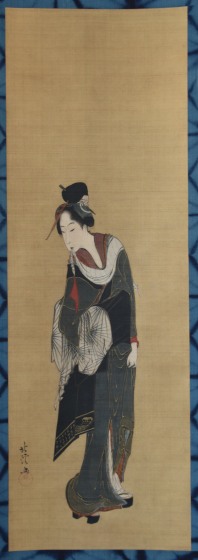
Click here to view image full size.
50th Anniversary of dealing – Part 2
In the 70s and 80s I was buying prints by such artists as Hiroshige, Hokusai, and Utamaro in the UK and in France and selling them in Japan. In Japan, I was buying prints by Yoshitoshi and Kuniyoshi. At that time those artists were not so highly valued by Japanese collectors.
I travelled to Paris every ten days or so and on almost every trip I was able to find something good. A lot of prints had been exported to France in the 19th century. Japanese art and culture enjoyed great influence in France at that time, the importance of ukiyo-e for the French impressionists is well known. Now it is difficult to find good quality prints in France and the prices fetched in auctions are often prohibitive.
At the time of my early trips to Japan in the 70s, there were not so many European or American visitors to Tokyo, visitor numbers to Japan were in the low 100,000s. Now visitor numbers are approaching 25 million per annum. My first experience of central Tokyo was a revelation – a real shock of the new! Tokyo’s highrise office blocks, its modern and efficient transport system, the bullet train all made London feel quite parochial. Because I had been studying ukiyo-e, Kyoto seemed much more familiar to me – if you squinted it was like being in a Hiroshige landscape.
My days were tiring ones of walking around shops in both cities. Prints could turn up anywhere. Outside of the cities it was not unusual for me to be followed by a gaggle of children for whom I was clearly a source of curiosity and general amusement.
I attended various auctions in Japan and often I was the only foreign dealer. The auctions were smaller then and some were held in ryokans in locations such as Hakone. Some dealers wore old style Japanese clothes (montsuki kimono beneath the montsuki haori and hakuma with socks and sandals). Everyone sat on tatami mats, the prints were passed around and bids were written on slips of paper in cardboard holders which were then thrown to the auctioneer. It was considered polite to bid on every few prints even if you didn’t want them; this was a matter of some delicacy which entailed making a bid low enough so as not to buy the item, but of course not so low that it would cause offense. Payment was cash only. Nowadays the accounts are computerised but in those days we had one man who did all the accounting on an abacus and would match a computer for speed. The auction was followed by dinner and then a dip in the communal male pool with much joshing.
At that time there was little interaction between Japanese dealers (except at these small auctions) and it was quite possible to buy a print from one shop, walk down the street and sell it to another shop because the dealers never went into each other’s premises. Over the years this has changed – as has so much else. I have been in the business for so long, I find myself dealing with the sons, daughters and sometimes the grandchildren of the dealers I met when I first travelled to Japan. I think that the aptitude for dealing and most importantly a good ‘eye’ must be carried in the genes.
The modern successor to those auctions is the official dealers’ auction held a number of times a year in the centre of Tokyo. They are much larger affairs with more foreign dealers and the ‘shout bid’ system mainly being used.
I was the first dealer to actively buy and champion surimono. In 1975 I had an exhibition of them and issued several catalogues of surimono over the following years. Then, as now, in fine surimono you can find exquisite sophistication in the cutting and printing of these short run editions for various poetry groups. In the 70s these wonderful prints were surprisingly affordable. Many surimono were exported from Japan in the latter part of the 19th century when there was a big demand for them, especially in Europe. To cope with this demand, from time to time, copies of surimono were produced. I think that the reasons that other dealers had avoided surimono in those early days was because of the risk of fakes and also expertise was determined by who had the opportunity to handle the genuine items. Because of the large number exported, curiously it was easier to find authentic surimono in France than it was in Japan.
In the Part 1 of this 50th anniversary blog I wrote about the importance of a good reference library, but to really know prints you also have to hold them in your hand. When handling prints the quality of the impression and of the paper is immediately evident. Surimono were printed on the finest of hosho which is a heavier paper that could hold the calligraphy, blind printing, and the addition of gold and other metals.
Another specific area in which I had an interest, which I still have to this day, is Shijo material: books, prints and paintings. In those early days Shijo was not considered collectable or as appreciated as formal styles. This changed somewhat after the publication of Jack Hillier’s The Uninhibited Brush in 1979.
Over the years I have noticed that prints travel in circles and I occasionally buy back the same items. I was passing an antique shop in the centre of Tokyo one time when I saw a first edition Hiroshige hanging on the wall. On inspecting it I realised that I had previously owned it. It was a very fine print so I purchased it again from that antique shop. That print had travelled between Japan and Europe four times to my certain knowledge. As it was some time ago, I am not sure where it went onto when I sold it next – it could be anywhere by now, I just hope that it has been cared for and is still in good condition.
I have had the pleasure of selling to many fine collectors. Then, as now, people find pleasure in their prints in different ways. For many years I sold Hiroshiges to one collector. She was a charming, elderly lady who one day confided to me that, whilst she loved the landscapes, she didn’t really like the bright colours. She told me that she had arrived at a method to get the colour saturation just as she liked it: she placed the prints in full sun on her balcony with pebbles on each corner and left the colours to fade until she was satisfied. Whilst I remember her fondly I do wince when I think of mint condition prints being intentionally faded.
Especially at this time when fine prints are increasingly difficult to find, I think of dealers and collectors alike as custodians for the next generations. I ask that you please look after your prints sensibly. Prints should be stored in acid free paper away from light and damp. They can be displayed but should be kept away from direct sunlight and rotated occasionally; and ideally not sealed in frames so that they can breathe.
About two years ago I viewed an auction in London that had four surimono. I saw that they were purchased from me about 20 years ago. My price for these surimono, which at that time were in pristine condition, was £25. Unfortunately, they had been stored somewhere damp and their condition was very poor. If they had been well looked after and had remained in fine condition I would have happily paid £2000 each for them but, as it was, I didn’t consider buying them. Many prints have become ghosts of their original selves because they have not been sensibly looked after.
I should like to thank those of you who are collectors and those who are interested in the research that I have done over the years; warm thanks to my colleagues for their companionship and shared knowledge; and last but not least, thanks to my wife Lynne for her interest and invaluable help in the business.
In this year of the 50th anniversary of dealing I look forward to continuing to offer fine prints, paintings and books for many years to come.
Richard Kruml 2018
50th Anniversary of dealing – Part 1
Looking back on 50 years of dealing in Japanese prints, paintings and books I have much to be grateful for. From the first ukiyo-e print that I bought in 1968 to now when I have bought and sold many tens of thousands of prints. In researching specific prints I have built up my kno
wledge of the artists and the artisans involved in print production. I continue to learn about the history, culture, and society that all gave rise and shaped what we know as ukiyo-e. Handling and knowing this art of 17th to 19th century Japan has been, and continues to be, a great pleasure and privilege for me.
I was fortunate that when I began as a dealer, it was at a time when prints were readily available and there was a wave of interest in Japanese art. I came to dealing after working as a professional photographer for a few years in London in the ‘swinging 60s’. I started buying and selling prints – initially book plates, Hogarth prints, maps and caricatures, I had a stall in an antiques market and was beginning to almost make a living. In 1968, by chance, I went into a shop just off Charing Cross Road that sold Japanese antiquities. On the wall was a print of a samurai by Kuniyoshi. I was familiar with engravings and etchings but I had never seen a printing technique like that. I was so excited by the print that I paid £40 for it – an extravagant price at that time! I put it on my stall in the Antique Centre near Selfridges. It took me three years to sell it and I made a big loss. This was the beginning of my education as a Japanese print dealer. I am often asked “How do I become a dealer?” My answer is: spend money, make mistakes, and keep learning.
Fortunately, not all of my learning was as a result of expensive mistakes, my first coup was finding Hokusai’s Great Wave in an outside antique market. It looked genuine but I wasn’t certain because I had never had one before. I paid the price of £10 which by today’s standards is insignificant (an impression of the Great Wave recently sold for about £720,000) and rushed to the Westminster Central Reference Library and pulled out all the books with illustrations of the Great Wave. I quickly discovered how much the prints varied and learned that no two impressions of any woodblock print can be absolutely identical. Since that personal ‘light bulb’ moment I have built up my knowledge of many individual designs. From learning to look for small breaks in the key block and other irregularities that should be repeated on each genuine impression of the Great Wave, I have gone on to become knowledgeable about many other specific wood blocks; learning about the often significant changes made when the blocks were recut, the histories of repairs and the history of the unique wood grain as it wears with each impression. I also learned about how much the pigments can vary in different impressions. The placing and wiping of the pigment will subtly differ and runs of prints on separate days can result in different hues or even very different colours. Climate conditions at the time of printing also affected the print quality. [For more information on the techniques of woodblock printing you might be interested to refer to my Chapter: The Technique of Japanese Printmaking in Ukiyo-e to Shin hanga, The Art of Japanese Woodblock Prints, Magna Books, 1990.]
It was then that I recognised the value of a good reference library and now I have hundreds of reference books and monographs on ukiyo-e artists which I use in my cataloguing. A few of the reference books that I refer to most regularly include are in blog [Selected Reference Titles] A word of warning: whilst most books illustrate genuine impressions – not all of them do!
In the 1970s, prints were, for the most part, affordable and relatively easy to find in London and the home counties. I used to take my car, an old Morris Traveller, to make buying trips around the countryside – I always found something to buy. (I still regularly make buying trips but now it means travelling worldwide.) Prints turned up in the most unusual places: two first edition Hiroshige snow scenes were found in the lining of a large wooden trunk in Scotland; decades later, I was offered an album of Kunisada that had been found sticking out of a dustbin in Hampstead!
In the 70s there were prints to be found in the market on Portobello Road. On one occasion it took some guile to acquire the item I wanted. There was a dealer who had Japanese prints amongst other items in an antique arcade. He was well known for his reluctance to sell to other dealers. One Saturday I walked in and looked through a pile of Hokusai reproductions, all priced at £5. Amongst the reproductions there was a completely genuine Hokusai in fine condition. (It happens sometimes that a fine condition print looks almost ‘too good’ and it is assumed to be a reproduction.) I thought that he would refuse to sell it to me – knowing that I only dealt in fine prints he would be suspicious that I wished to buy a reproduction. I left the shop as nonchalantly as I could so that I could think about what to do. With a bit of astonishing good luck – walking down the street came a client of mine who at the time worked for JAL and would always come and see me on his stop over. I told him the situation and he agreed to help me. He was successful in buying the genuine Hokusai print (at the cost of a reproduction). The next time I was in the arcade and saw that dealer, I could tell by his expression that he had had time to think about the transaction and had guessed what had happened.
In the 70s Knight, Frank and Rutley (the well-known estate agents) had a saleroom just off Bond Street and had regular weekday antique sales. Japanese prints frequently came up amongst the furniture. At one of these auctions a large pile of Hiroshiges came up. I could only afford £1 per print and was outbid. It is common for dealers to have a personal history of ‘ones that got away’ – those Hiroshiges were the first for me in that category and to this day I still wish that my budget had been bigger and still wonder what happened to them.
By the late 70s I had moved my business from the antiques market into a small shared gallery off Bond Street. The gallery was on the ground floor and faced a restaurant across a narrow street. I could see diners enjoying their lunch and they could see me at work. One day a Japanese dealer came to see me. He selected a pile of prints, and after some negotiation we agreed a price. At this point in the story, the position of the restaurant diners becomes important. As the dealer prepared to pay me, he turned his back to me and (oblivious of the diners opposite), he dropped his trousers to expose long johns and somewhere between his legs a bag of cash. Across the road knives and forks froze in mid-air, all conversation and service paused while this corpulent dealer revealed a little bit more than his security arrangements.
End
You may be interested to read further reminiscences from my early years of dealing in Part 2 which will soon go live on the website together with the 50th Anniversary special update.
Selected Reference Titles
Listed here are selected titles of reference books that I refer to most regularly – this is not an exhaustive list!
Asano, Shugo and Clark, Timothy, The Passionate Art of Kitagaway Utamaro, Asahi Shimbun, 1995
Forrer, Matthi and Goncourt, Edmond de, Hokusai, Rizzoli International Publications, 1988
Gentles, Margarent O., The Clarence Buckingham Collection of Japanese Prints, Volume 2 Haranobu, Koryusai,Shigemasa, their followers and contemporaries , The Art Institute of Chicago, 1955
Gunsaulus, Helen C., The Clarence Buckingham Collection of Japanese Prints, Volume 1 The Primitives, The Art Institute of Chicago, 1955
Hillier, Jack, The uninhibited brush, Japanese Art in the Shijo Style, Hugh M. Moss Ltd, 1974
Hillier, Jack, The Art of the Japanese Book, 2 volumes, Southeby Publications, 1987
Hirano Chie, Kiyonaga A Study of His Life and Works, Harvard University Press 1939
Keyes, Roger, The Art of Surimono, Privately Published Japanese Woodblock Prints and Books in the Chester Beatty Library, Dublin, Southeby Publications, 1985
Keyes, Roger, The Art of Surimono, two volumes, Southeby Publications, 1985
Koop, Albert J., and Ianda, Hogitaro, Japanese Names and How to Read Them, Routledge & Kegan Paul Ltd., 1923
Lane, Richard, Images from the Floating World, The Japanese Print Including a Dictionary of Ukiyo-e, Oxford University Press, 1978
Mitchell, C.H., The Illustrated Books of Nanga, Maruyama, Shijo and Other Related Schools of Japan, Dawson’s Book Shop, 1972
Robinson, B.W., Kuniyoshi, The Warrior Prints, Phaidon Press, 1982
Schaap, Robert, Heroes & Ghosts, Japanese Prints by Kuniyoshi 1797 – 1861, Hotei Publishing, 1998
Suzuki, Juzo, Utagawa Hiroshige, The Nihon Keizai Shimbun, 1970
Tamba, Tsuneo, The Art of Hiroshige, Asahi Shimbun, 1965
Turk, Frank A., The Prints of Japan, Arco Publications, 1966
Van den Ing, Eric and Schaap, Robert, Beauty & Violence, Japanese Prints by Yoshitoshi 1839 – 1892, Havilland Press, Society for Japanese Arts, 1992
Yanagawa SHIGENOBU (1787-1833)
Click here to view image full size.
An original painting by this artist who was the pupil and then son-in-law of Hokusai. He was given the name Yanagawa (from his residence in the Honjo district of Edo) to distinguish him from other Shigenobu artists. A good book illustrator and surimono designer. He designed the first square surimono in Osaka in 1822, inspiring others to follow. His paintings are rare. Shows a portrait of the Japanese scholar and writer Ishikawa Masamochi (1754-1830). The fifth son of Ishikawa Toyonobu, he was a renowned kyoka poet and Gesaku writer (playful, mocking works), including The Magical Carpenter of Japan. An important figure in kyoka/surimono circles. Known as Rokujuen (Yadao no Meshimori). His family crest is seen on his kimono and he sits before a low desk ready to write. A high quality painting, sumi and colour on silk, 29 x 12.5 in.; 73.6 x 31.8 cms. Several small backed wormholes at bottom, otherwise very good condition. Would benefit from being remounted.
Signed Shigenobu with seal Yanagawa.
Status: Available
Maki Bokusen (1736-1824)
Given names: Bokusen; Maki-Nobumitsu Bokusen; Gekkotei; Hokusen; Hokutei; Hyakusai; Maki Shin’ei; Suke-emon; Tokoro; Utamasa.
Bokusen was a Nagoya samurai of the local Owari Fief and ukiyo-e painter, printmaker and copperplate etcher. He was a student of Utamaro and also, as C H Mitchell states, a friend and acknowledged pupil of Hokusai although much of his work bears little resemblance to that of Hokusai.
Bokusen is known for his collaboration with Hokusai on the master’s Manga: It seems that the idea was conceived when Hokusai, at Bokusen’s invitation, went to Nagoya for an extended visit in 1811/12. Hokusai stayed for six months with Bokusen and during this time developed a circle of students and successfully cultivated his popularity in Nagoya. Hanshu Sanjin in his 1812 preface to Volume One of Hokusai’s Manga writes that over 300 spontaneous drawings were made during this visit. And this is what possibly inspired Bokusen to approach the legendary Nagoya publisher Eirakuya Toshiro, who had previously published illustrated book(s) by him, to turn Hokusai’s sketches into a book. Bokusen and another of Hokusai’s students, Tonansai Hokuun, are credited as copying Hokusai’s drawings in preparation for the woodblock cutter as the term “ko” or “revisers” is used in the colophon, suggesting that it was the two pupils who arranged the varied sketches.
Bokusen’s own published works include:
c1809 Kyogaen shohen. (Mad Sketches)
1809 Bokusen gafu (Album of Sketches by Bokusen)
1810 Hitoyo banashi (One Evening’s Talk)
1813 Shiki sanbaso (The Sanbaso in Four Seasons)
1814 Mushi no koe (Songs of insects). Bokusen and other artists
1815 Bokusen soga shashin gakuhitsu (Various Dreamings by Bokusen: A Study in Truthful Painting)
1816 Santei gafu. Bokusen and Hokusai publish a Manual for Illustration in Three Styles. The illustrations in this publication apply shin, gyo, and so styles to depict a range of subjects
1822 Kusa no na shu (Aki) (Collection of Autumn Grasses). Various artists including Bokusen
1823 Ippitsu gafu (A Book of Drawings Made by One Stroke of the Brush) Hokusai assisted by Bokusen
1827 Kusa no na shu (Haru fuyu) (Collection of Spring and Winter Grasses). Various artists including Bokusen
Bokusen’s work in copperplate etching is not well known to collectors of ukiyo-e, certainly not compared with his better recognised contemporaries Kokan (1747-1818) and Denzen (1748-1822) who used the technology for familiar subjects such as famous views of Edo to create a new type of image that integrated pictorial traditions of the West. Bokusen’s work with copperplate etchings was concerned with a scientific accuracy and faithfulness to the original illustration. For the Japanese translation Surgical Medicine, he produced copper-etching prints based on the illustrations in Lorenz Heister’s Heelkundige Onderwyzingen.
Bokusen’s books, paintings and prints are held in international museum collections.
Please follow this link to see an image of his painting Courtesan and Teenage Appentice in the Museum of Fine Art Boston.
To accompany this blog I am offering for sale an original Bokusen painting, full colour on silk.
Winter landscapes
Approximately 70% of Japan’s landscape is mountainous. In the past when travel into the mountains was difficult there was a large demand and great curiosity by the public to see those remote snow covered landscapes. Publishers and leading artists like Hiroshige and Hokusai responded to that demand by ensuring that every landscape set had at least one snow scene and, often, as in the 100 Views of Edo set, there were as many as seven.
Winter landscapes, because of their minimalist nature appeal to a modern aesthetic and are probably the most popular and expensive landscape prints to collect now. They most often show travellers in a snowy pass but we can also enjoy scenes of Edo (Tokyo) under deep snow. Tokyo’s location on the coast of the Pacific Ocean affords the city mild winters with cool spells. Snowfall does occur annually but it is sporadic and it seldom stays. Perhaps there were heavier falls one or two hundred years ago but more likely artists used snow imagery as a way to both emphasise the season and to transform both landscape and cityscape.
In ukiyo-e a number of techniques were used to suggest snow: areas of image were left blank or block cutters and printers created texture on the paper using gauffrage (blind-printing) in which the block is printed without pigment. This convincingly conveyed snow and is primarily found on prints of the Harunobu period and surimono both of which were printed using thick hosho which is ideal for blind-printing.
White pigment was also used: gofun which was prepared from powdered clam shells [calcium carbonate] or shiro prepared from white lead carbonate. Snowflakes could be cut into the blocks and printed; or gofun or shiro could be splashed from a brush onto the paper, or applied by using a right-angle pipette. It could also be applied by taking it into the mouth and spraying through the lips. Splashed pigment is also commonly used to suggest sprayed water.
The shiro usually oxidises over time so that in some prints it appears to be snowing black snow. This is the result of the print’s exposure to air borne acid pollution. Not all oxidation is unpleasant: it can give a print an attractive patina. Print collectors will have noticed another effect of oxidisation- the shiro was also mixed with red for flesh tones which is why one comes across blackened faces on some prints. Oxidation can be easily reversed by a restorer, and once professionally reversed will be stable.
Utagawa HIROSHIGE (1797-1858)
Click here to view image full size.
A bora, grey mullet (Mugil cephalus), together with camellia and Japanese asparagusudo. This impression is from the extremely rare first private edition for a poetry club with the judges’ names beside the kyoka poems by Higaki Kunifune and Toshinoto Haruki. From a set of ten prints published – most likely – by Eijudo around 1832-34. These prints were subsequently issued commercially by Eijudo with his seal and a kiwame seal (both missing here on the private printing) and with the judges’ names removed. Who the poetry group was is not known, but they must have been affluent and influential. Of the sixteen poets on the prints, four were certainly members of the Shingyoku Circle, which was affiliated to the Yomogawa. This was the group that commissioned, amongst others, Hokusai’s Horse and Shell series of surimono. There appear to be three other impressions known from the private edition: Sebastian Izzard, Hiroshige, The Ukiyo-e Society of America Inc., 1983, no. 5; Ukiyo-e art, no. 18, Memeorial exhibition of Hiroshige, The Japan Ukiyo-e Society, 1968 (C) no. 4; and Juzo Suzuki, Utagawa Hiroshige, Nihon Keizai Shinbun, 1970, no. 593. Provenance: Ex Stoclet collection.
Very fine impression. Fine colour. Centre fold (as usual as they were issued in folding album form), otherwise fine condition. Signed Ichiryusai Hiroshige ga.
Status: Sold
Teisai HOKUBA (1771-1844)

Click here to view image full size.
An original painting on silk in full colour. Image size 36.5 x 13.5 in; 92.75 x 34.25 cms. A fine painting showing beauties from different social strata: A farmer’s wife; a courtesan; an elegant wife; and a Heian period court beauty. Hokuba was one of the earliest and best of Hokusai’s pupils. A printmaker, but only of surimono, book illustrator, and, most importantly, a fine painter. Above is a kyoka poem by Ota Nanpo (1749-1823), a famous poet and fiction writer. Silk slightly browned and minimal loss of some pigment but in otherwise good condition. Old mount: Would benefit from remounting. Painted Bunsei period, c. early 1820s.
Signed Teisai Hokuba ga with seals Hoku Ba.
Status: Sold
Utagawa KUNINAO (1793-1854)

Click here to view image full size.

Click here to view image full size.
A pair of original paintings: One showing a beauty being followed by her servant down a jetty into a waiting boat. He protects her with an umbrella in one hand and carries food on a tray with the other. The whole scene under heavy snow. The other painting shows a beauty composing a poem. Above a wild goose flies before a full moon. Probably originally two of three setsu-getsu-ka, “Snow, Moon, Flowers.” A theme popular with ukiyo-e artists and originally derived from China. Kuninao studied under Toyokuni and then Hokusai and is also known for many illustrated books. His paintings now rare. Each painting full colour on silk, image size 36.5 x 12.75 in; 92.5 x 32.5 cms. In excellent condition. Beautifully presented with new mounts. One painting signed Kohsoen hitsu with seal Shohzan.
Status: Sold
Teisai HOKUBA (1771-1844)
Click here to view image full size.
A large original painting, full colour on paper, 49 x 22.5 in; 124.5 x 57 cms. Shows a beauty caught in an autumnal breeze, the tree above shedding its leaves. One of Hokusai’s earliest and best pupils and, apart from painting , is also known for his surimono and book illustration. Famous for his meticulous paintings of beauties, Hokuba also produced these loose impromptu paintings using rapid brushstrokes. Painted in Bunka period (1804-1818).
Some slight rubbing of paper at top, but in surprisingly good condition given its size. Newly mounted. Signed Hokuba ga with Hokuba seal.
Status: Sold
Katsukawa SHUNSHO ( 1726-1792 )
Click here to view image full size.
An extremely important painting by one of the most important artists of his day. One of the great ukiyo-e print designers – especially of actor prints. He lived in Edo and first studied under Katsukawa Shunsui and Ko Sukoku. Little is known of his private life. He had many able pupils including Hokusai. The seal he used had Hayashi on the side of a jar ( tsubo ), hence he was called Tsubo. In 1776, together with Kitao Shigemasa, illustrated the famous book Seiro bijin awase sugata kagami. Also the Ehon butai ogi with Buncho in 1770.
This was one of the paintings chosen to be exhibited at the Isetan Department Store to commemorate the Tokyo Olympics in 1964. The exhibit arranged by The Mainichi Newspapers. A committee consisting of Mr. Seiichiro Takahashi, president of the Japan Art Academy, Mr. Issho Tanaka, director of the Tokyo National Cultural Assets Research Institute, Mr. Seiroku Noma, an historian, Mr. Muneshige Narasaki, chairman of the Ukiyoe Association, Mr. Sadao Kikuchi of the Tokyo National Museum, Mr. Teruji Yoshida, an Ukiyoe connoisseur, Mr. Fusui Kaneko, an Ukiyoe connoisseur, Mr. Yasunosuke Ogiwara, an Ukiyoe connoisseur, and other collectors vetted all the paintings and they represented the best that could be put together at the time. Full colour on silk including gold leaf. Exquisitly painted. Slightly creased otherwise in good condition. Double box with inscription in gold. Image size 39 x 12.5 in; 99 x 31.75 cms. Painted c 1781-9.
Signed Katsu Shunsho ga with seal. Ex collection Oda Eisaku, a famous art dealer and collector.
Status: Sold
Manjiro HOKUGA (Fl. early to mid 19th century)
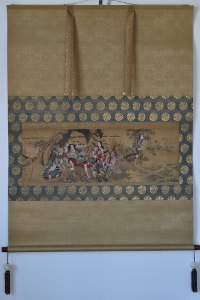
Click here to view image full size.
A large original painting, full colour on silk, 11.5 x 34.5 in; 29.2 x 87.7 cms. Shows Tametomo, a famed archer of extraordinary strength who was exiled to Oshima by the Emperor. During his sojourn Tametomo discovered Onigashima, an island inhabited by devils who he subordinated. News of this reached the Emperor who sent a fleet of vessels to capture him. On sighting the nearest boat Tametomo fires an arrow and sinks the ship and three hundred men. There is a famous version of this subject painted by Hokusai in the BM (see Ukiyo-e Paintings in the British Museum, Timothy Clark, 1992, no. 96, p. 146). Hokuga, a pupil of Hokusai, specialised in surimono. Probably Hokuga’s masterpiece.
Silk slightly darkened, otherwise very good condition. Recently remounted. Signed Manjiro Hokuga with seals Hoku Ga.
Status: Sold
Numata GESSAI (UTAMASA) (1787-1864)
Click here to view image full size.
An original painting showing a geisha looking back over her shoulder as though surprised. The kimono is beautifully painted with waves and cherry blossom in gofun. Full colour on paper, 50 x 20.25 in; 127 x 51.4 cms. He first studied under Maki Bokusen, then Hokusai during his stay in Nagoya. In the 1840s he was a pupil of Cho Gessho finishing by studying the nanga manner under Yamamoto Baiitsu. Another example is in the MFA, acc no. 11.7340, ex William Sturgis Bigelow collection. In very good condition and newly mounted. Signed Gessai with seal Utamasa.
Status: Sold
Click here to view image full size.
Teisai HOKUBA (1771-1844)

Click here to view image full size.
An original painting, full colour on silk, image size 37.5 x 12.75in; 95.2 x 32.3 cms. One of Hokusai’s earliest and best pupils. Produced a few surimono, also illustrated books, but is best known for his paintings of bijin, often shown promenading along the Sumida River, as here. Above is flowering cherry blossom setting the scene in late March or early April. The background is in Kano ink-wash showing boats on the river and below a ferry landing stage which she is presumably making her way towards. A similar painting is in the BM, illustrated in Ukiyo-e Paintings in the British Museum, Timothy Clark, 1992, p. 120, p. 169. Painted c 1830-44. In good condition. Signed Teisai with seal Hokuba gain.
Status: Sold
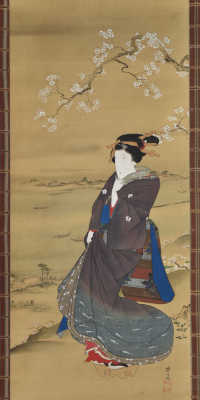
Click here to view image full size.
Maki BOKUSEN (1736-1814)
Click here to view image full size.
A fine original painting, full colour on silk, 40.5 x 12.5 in; 102.9 x 31.7 cms showing a beauty reading a long (love ?) letter. Her maid on the floor beside her. Bokusen was a pupil of both Utamaro and Hokusai although he had an independent style with Hokusai elements in his painting. He was not only a painter but printmaker and book illustrator with such books as: Bokusen gafu (1809), Hitoyo banashi (1810) etc. Painted c1810s.
Very good condition. Signed and sealed Bokusen. See my Blog on this update.
Status: Sold
Katsushika TAITO II (Active c. 1810-1853)
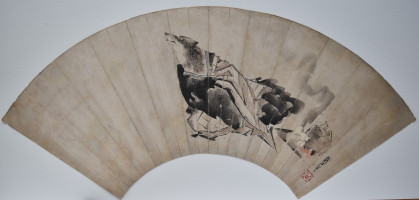
Click here to view image full size.
An original fan painting, sumi and light colour on prepared paper, 7.5 x 21.5 in; 19 x 54.5 cms. Shows a badger disguised as a priest. This is the same story as is illustrated in Yoshitoshi’s Shingata sanjurokkaisen, “Thirty-six Supernatural Beings in New Forms” showing the badger at Morinji Temple that could turn itself into a teakettle. Taito II was given the go of Taito by Hokusai, whose pupil he was, in 1820. The fan has the original rib marks and has minor wear, but is in generally good condition. The paper treated with mica. Signed Taito hitsu with Hyaku seal.
Status: Sold
Katsukawa SHUNSHO (1726?-1792)

Click here to view image full size.
An original painting, sumi and full colour on silk, 32.25 x 10 in; 82 x 25.5 cms. An important print artist and his paintings being considered one of the glories of Ukiyo-e. Produced a considerable number of hosoban actor prints from the late 1760s on as well as collaborating on the Ehon butai ogi illustrated book with Buncho in 1770 and Seiro bijin awase sugata kagami with Kitao Shigemasa in 1776. He had many pupils including Shunko, Shun’ei and Hokusai. Shows a court beauty reclining and reading a book. The painting of the face, hair and the lacquer stand holding the cloth screen are exceptional. Painted c. 1789. In very good condition.
Signed Katsu Shunsho ga with seal Jui.
Status: Sold
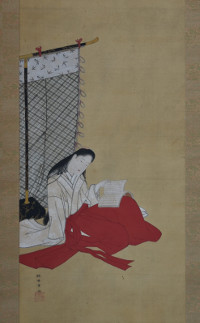
Click here to view image full size.
Utagawa HIROSHIGE (1797-1858)
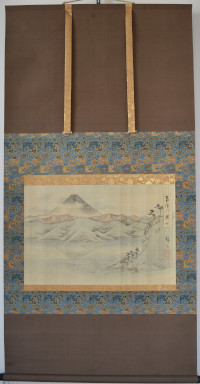
Click here to view image full size.
An original painting, sumi and light colour on silk, 14.5 x 22 in; 36.8 x 55.9 cms. Labelled on the right Hakone no kosui, “The Lake of Hakone.” Shows the reflection of Fuji in Lake Kawaguchi with the Misaka mountain range. A similar view could be seen from Lake Ashi. Hokusai produced a version for for the Thirty-six Views of Fuji set and this area was the subject of a number of Hiroshige prints. Signed Hiroshige with Ichiryusai seal. In very good condition.
Status: Sold
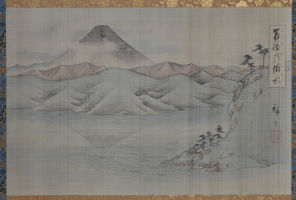
Click here to view image full size.
